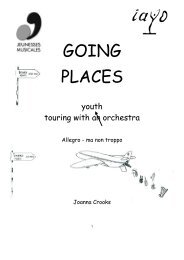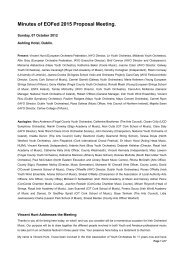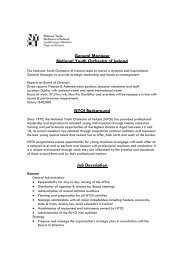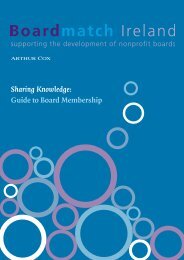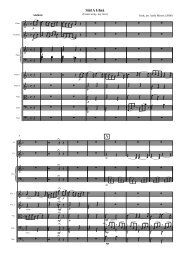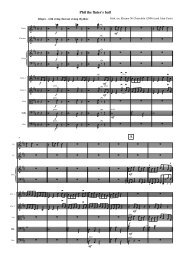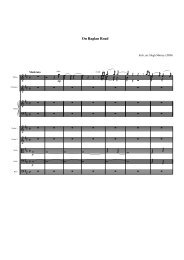A SOUND EAR II - Association of British Orchestras
A SOUND EAR II - Association of British Orchestras
A SOUND EAR II - Association of British Orchestras
Create successful ePaper yourself
Turn your PDF publications into a flip-book with our unique Google optimized e-Paper software.
A <strong>SOUND</strong> <strong>EAR</strong> <strong>II</strong><br />
Options for controlling noise<br />
Each <strong>of</strong> the following control measures will provide some dose reduction, and be usable in some circumstances more<br />
than others. The worst daily dose on record is 98dB 4 , so the total amount <strong>of</strong> reduction needed is not that much (though<br />
still difficult to achieve). Shaving a bit <strong>of</strong>f the dose here and there may be all that is possible, and as much as is necessary.<br />
Get the conductor onside<br />
Add noise to the list <strong>of</strong> criteria in developing programmes,<br />
and at least avoid putting huge forces on small flat stages.<br />
Get new composers onside<br />
Play less loudly<br />
• Sometimes the excitement can be increased but the exposures reduced by accentuating the quieter areas around<br />
very high power segments.<br />
• Use practice mutes or practice pads during personal practice<br />
• Keep piano lid down during personal practice<br />
• When teaching, encourage students to keep it down<br />
• When teaching in groups, avoid constant ‘group practice’<br />
• How loud does the rehearsal need to be?<br />
Use less powerful instruments – particularly in the brass<br />
Nobody is suggesting switching to period instruments, but different modern brass instruments have different power<br />
ranges. The more powerful instruments are popular, because they require less playing force. However, if they are<br />
played at high power they force up the dynamic <strong>of</strong> the orchestra. External observers do feel that orchestras have<br />
become louder in the last 30 years.<br />
25<br />
Improve projection by:<br />
using high risers – at least 50cm above the row in front<br />
High risers – akin to a return to the old town-hall layout – are readily available in some venues. In others you may<br />
need to consider investing in your own (with the ensuing transport and handling and set up problems), or joining<br />
with other orchestras to lobby for improvements at the venue, or trying a different layout.<br />
High risers make a considerable difference – in one orchestra, players thought the brass were pulling an elaborate practical<br />
joke by playing far too loud. In fact, they were playing as usual, but for the first time they were no longer obstructed by<br />
rows <strong>of</strong> human sound absorbers. Players on high risers need good feedback from the conductor, will not instantly turn<br />
down the sound, and may have difficulty if they keep having to switch between obstructed and unobstructed layouts.<br />
NB, if an instrument’s sound output goes downwards, high risers may increase the risk to neighbours.<br />
putting noisy sections at the sides<br />
Many chamber ensembles block the noiser sections at the side, rather than at the back. They are not completely<br />
unobstructed, but do have fewer rows <strong>of</strong> musicians in front, and fewer people in front feeling that they are being assaulted.<br />
putting noisy sections at the front<br />
This sounds bizarre but has been tried by a number <strong>of</strong> ensembles, with considerable success. The orchestra can be<br />
laid out ‘back to front’, with the brass nearest the conductor and strings furthest.<br />
ensuring each noisy instrument has a clear soundline to the audience<br />
Where you have horizontal space, you can spread the orchestra out so that sound passes between players, rather<br />
than through them. Initially, this will affect ensemble, but orchestras that have tried it have strongly preferred the<br />
generous layout. Even where the whole orchestra cannot be dispersed, you may be able to develop sound channels<br />
for particularly high risk instruments.<br />
4<br />
There are plenty <strong>of</strong> 97 and 96 days, but the restrictions <strong>of</strong> lung-powered instruments seem to create a ceiling<br />
at 98, So far.



